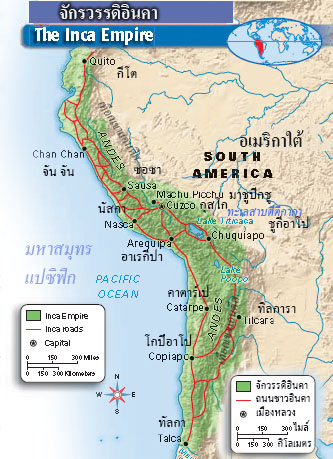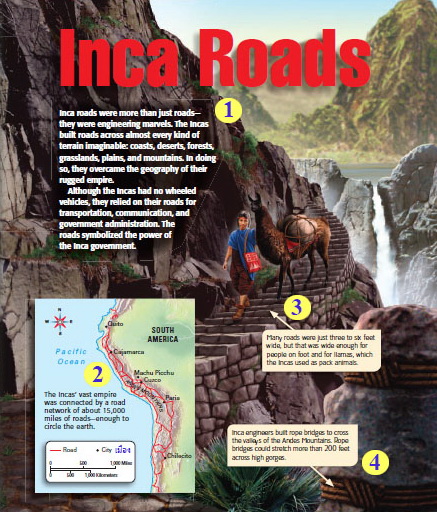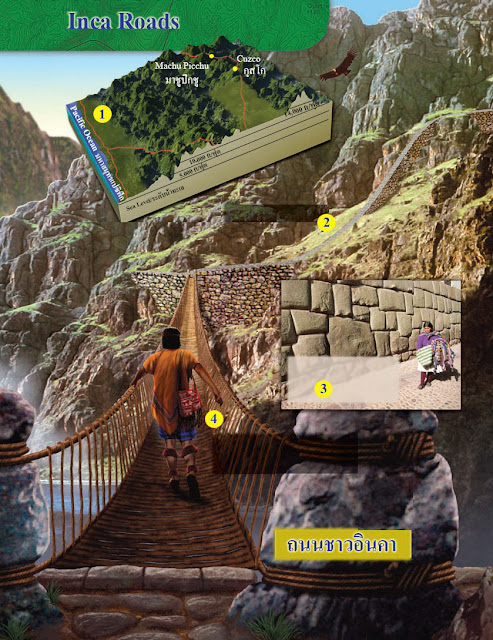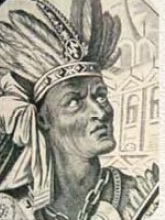The Incas
The Incas Create an
Empire
While the Aztecs
were ruling Mexico, the Inca Empire arose in South
America. The Incas began as a small tribe in the Andes. Their capital was Cuzco in what is now Peru. In
the mid-1400s a ruler named Pachacuti began to
expand Inca territory. Later leaders followed his example, and by the early 1500s the Inca Empire was huge. It stretched from modern Ecuador to
central Chile and included coastal deserts, snowy
mountains, fertile valleys, and thick forests. About 12
million people lived in the empire. To rule effectively, the Incas formed a strong central government.
|
ชาวอินคา
ชาวอินคาสร้างจักรวรรดิ
ในขณะที่ชาวแอซเท็กกำลังปกครองเม็กซิโก
จักรวรรดิอินคาก็อุบัติขึ้นในอเมริกาใต้ ชาวอินคาเริ่มเป็นเผ่าเล็ก ๆ
ในภูเขาแอนดีส เมืองหลวงของชาวอินคา คือ กุสโก ซึ่งปัจจุบันนี้คือประเทศเปรู
ในตอนกลางศตวรรษที่ 1400 นักปกครองนามว่า ปาชากูตี เริ่มขยายดินแดนอินคา
เหล่าผู้นำยุคต่อมาก็ทำตามตัวอย่างพระองค์ และประมาณต้นศตวรรษที่ 1500 จักรวรรดิอินคาใหญ่โตมหึมา
ยาวเหยียดจากประเทศเอกวาดอร์ในปัจจุบันจนถึงตอนกลางของประเทศชิลีและรวมถึงทะเลทรายใกล้ชายฝั่งทะเล
ภูเขาที่มีหิมะ ลุ่มแม่น้ำที่อุดมสมบูรณ์ตลอดถึงป่าที่หนาทึบ ผู้คนประมาณ 12
ล้านคนอาศัยอยู่ในจักรวรรดิ ชาวอินคาได้จัดตั้งรัฐบาลที่เข้มแข็งเพื่อปกครองได้อย่างมีประสิทธิภาพ
|
The Incas lived in a
region of high plains and mountains.
|
ชาวอินคาอาศัยอยู่ในที่ราบสูงและภูเขา
|
Central Rule
Pachacuti did not
want the people he conquered to have too much power. He began a policy of removing local
leaders and replacing them with new officials he trusted. He also made the children of conquered leaders
travel to Cuzco to learn about Inca government and
religion. When the children were
grown, they were sent back to govern their villages,
where they taught people the Inca way of life.
As another means of
unifying the empire, the Incas used an official Inca
language, Quechua. Although people spoke many other languages, all official
business had to be done in Quechua. Even today, many
people in Peru speak Quechua.
A Well-Organized
Economy
The Inca government
strictly controlled the economy and told each household what work to do. Most Incas had to spend time working for the government as well as
themselves. Farmers tended government land
in addition to their own. Villagers made
cloth and other goods for the army. Some Incas served as
soldiers, worked in mines, or built roads and bridges. In this way, the people paid taxes in
the form of labor rather than money. This
labor tax system was called the mita.
Another feature of
the Inca economy was that there were no merchants or
markets. Instead, government officials would distribute goods collected through the mita. Leftover goods were stored in the capital
for emergencies. If a natural disaster struck,
or if people simply could not care for themselves, the
government provided supplies to help them.
|
การปกครองในส่วนกลาง
ปาชากูตีไม่ประสงค์จะให้ประชาชนที่พระองค์พิชิตมามีอำนาจมากเกินไป
จึงเริ่มวางนโยบายเคลื่อนย้ายเหล่าผู้นำท้องถิ่นและจัดข้าราชการใหม่ที่พระองค์ทรงไว้วางใจแทนตำแหน่งเหล่านั้น
พระองค์ยังได้ให้ลูก ๆ
ของเหล่าผู้นำที่พระองค์พิชิตได้เดินทางไปยังเมืองกุสโกเพื่อเล่าเรียนเกี่ยวกับการปกครองและศาสนาของชาวอินคา
ในขณะที่เด็ก ๆ เจริญเติบโต พวกเขาก็ถูกส่งกลับมาบริหารหมู่บ้านของตนเอง
ซึ่งพวกก็ได้สั่งสอนวิถีชีวิตของชาวอินคาให้กับประชาชน ณ ที่นั่น
ชาวอินคาได้ใช้ภาษาเกชัว (เกชูวู
ตามสำเนียงท้องถิ่น) ซึ่งเป็นภาษาทางการของชาวอินคาเป็นแนวทางหนึ่งในการรวบรวมจักรวรรดิให้เป็นเอกภาพ
แม้ประชาชนจะพูดภาษาอื่น ๆ หลากหลายภาษา
การทำธุรกิจของทางราชการทั้งหมดต้องทำเป็นภาษาเกชัว แม้ในปัจจุบันนี้
ยังมีประชาชนจำนวนมากในประเทศเปรูพูดภาษาเกชัว
เศรษฐกิจมีการจัดการได้เป็นอย่างดี
รัฐบาลอินคาเข้มงวดในการควบคุมเศรษฐกิจบอกให้ครอบครัวแต่ละครอบครัวว่าการงานชนิดใดที่ควรทำ
ชาวอินคาส่วนใหญ่ต้องใช้เวลาในการทำงานให้กับรัฐบาลและตัวเองด้วย เหล่าเกษตรกรคอยดูแลที่ดินของรัฐร่วมกับของตนเอง
ชาวบ้านจะทำเสื้อผ้าเครื่องและสินค้าอื่น ๆ ให้กับกองทัพ ชาวอินคาบางพวกทำงานบริการเป็นทหาร
ทำงานในเหมืองแร่ หรือสร้างถนนและสะพาน ด้วยวิธีนี้
ประชาชนจึงจ่ายภาษีในรูปของแรงงานค่อนข้างมากกว่าเงิน ระบบภาษีแรงงานนี้
เรียกว่า มีตา
ลักษณะเฉพาะอีกประการหนึ่งของเศรษฐกิจอินคาคือการไม่มีพ่อค้าหรือตลาด
เจ้าหน้าที่ของรัฐจะกระจายสินค้าที่เก็บรวบรวมไว้โดยวิธีมีตาแทน
สินค้าที่ล้นเหลือจะเก็บไว้ในเมืองหลวงเพื่อใช้ในภาวะฉุกเฉิน ถ้าเกิดภัยพิบัติทางธรรมชาติโจมตี
หรือยกตัวอย่างง่าย ๆ ถ้าประชาชนไม่สามารถดูแลตัวเองได้ รัฐบาลก็จัดเสบียงอาหารเพื่อช่วยเหลือประชาชนเหล่านั้น
|
The ruins of the Inca
city Machu Picchu, shown here, lie high in the Andes Mountains.
|
ซากปรักหักพังของเมืองมาชูปิกชูของชาวอินคาในภาพนี้ตั้งอยู่ในเทือกเขาแอนดีส
|
Life in the Inca
Empire
Because the rulers
controlled Inca society so closely, the common people
had little personal freedom. At the
same time, the government protected the general welfare of all in the empire. But that did not
mean everyone was treated equally.
Social Divisions
Inca society had two
main social classes. The emperor, priests, and
government officials made up the upper class. Members of this class lived in stone
houses in Cuzco and wore the best clothes.
They didn’t have to pay the
labor tax, and they enjoyed many other privileges. Inca rulers, for example, could relax
in luxury at Machu Picchu. This royal retreat lay nestled high in the Andes. Palaces
and gardens could be found behind its gated wall.
|
การดำเนินชีวิตในจักรวรรดิอินคา
เนื่องจากนักปกครองได้ควบคุมสังคมอินคาใกล้ชิดมาก
ประชาชนทั่วไปจึงมีอิสรภาพส่วนตัวน้อย ณ เวลาเดียวกันนั้น รัฐบาลปกป้องสวัสดิการสาธารณะทั้งหมดในจักรวรรดิ
แต่ไม่ได้หมายความว่าทุกคนจะได้รับการปฏิบัติอย่างเสมอภาค
การแบ่งชนชั้นทางสังคม
สังคมอินคามีชนชั้นทางสังคมหลักอยู่
2 ชนชั้น คือ จักรพรรดิ นักบวช และข้าราชการอยู่ในสังคมชั้นสูง สมาชิกในสังคมนี้อาศัยอยู่ในบ้านหินในเมืองกุสโกและสวมใส่เสื้อผ้าอย่างดีที่สุด
ทั้งไม่ได้จ่ายภาษีแรงงาน และมีได้รับสิทธิพิเศษ ยกตัวอย่างเช่น นักปกครองอินคาสามารถพักผ่อนหย่อนใจอย่างฟุ่มเฟือยในเมืองมาชูปิกชู
การพักผ่อนหย่อนใจของนักปกครองชั้นสูงนี้จะพักอยู่อย่างสบายใจสูงขึ้นไปในภูเขาแอนดีส
ปราสาทราชวังและอุทยานสามารถค้นพบได้เบื้องหลังกำแพงที่มีประตูใหญ่
|
ชาวอินคาส่วนมากเป็นเกษตรกร ในภาพนี้
ชาวอินคาในกลางศตวรรษที่ 1500 กำลังเก็บเกี่ยวมันฝรั่ง
|
Religion
The Inca social
structure was partly related to religion. For
example, the Incas thought that their rulers were
related to the sun god and never really died. As a result, priests brought mummies of
former kings to many ceremonies. People
gave these royal mummies food and gifts.
Inca ceremonies often
included sacrifices. But unlike the Maya and the Aztecs, the Incas rarely sacrificed humans. Instead they sacrificed llamas, cloth, or food.
In addition to practicing the
official religion, people outside Cuzco worshipped other gods at local sacred places. The
Incas believed certain mountaintops, rocks, and springs had magical powers. Many Incas performed sacrifices at these places as well as
at the temple in Cuzco.
Achievements
Inca temples were
grand buildings. The Incas were
master builders, known for their expert masonry,
or stonework. They cut stone blocks
so precisely that they didn’t need
cement to hold them together. The Incas also built a
network of roads. Two major highways ran the length of
the empire and linked to many other roads.
The Incas produced
works of art as well. Artisans made
pottery and gold and silver jewelry. They
even created a life-sized cornfield
of gold and silver, crafting each cob, leaf, and stalk
individually. Inca weavers also
made some of the finest textiles in the Americas.
While such artifacts tell us much
about the Incas, nothing was written about their empire until the Spanish arrived. Indeed, the Incas had no writing system. Instead, they kept records with knotted cords called quipus. Knots in the cords represented numbers. Different colors stood for information
about crops, land, and other important topics.
The Incas also passed down their history orally. People sang songs and told stories about daily life and military victories.
Official “memorizers” learned
long poems about Inca legends and history.
Eventually, after the conquistadors came, records
were written in Spanish and Quechua. We know about the
Incas from these records and from the stories that
survive in the songs, dances, and religious practices of the people in the region today.
|
ศาสนา
โครงสร้างทางสังคมของชาวอินคาบางส่วนเกี่ยวข้องกับศาสนา
ยกตัวอย่างเช่น ชาวอินคาคิดว่า นักปกครองของตนเองเกี่ยวพันกับสุริยเทพและไม่ได้สวรรคตจริง
ๆ จึงเป็นเหตุให้นักบวชนำมัมมี่ของเกษตรยุคแรกไปทำพิธีกรรมมากมาย ประชาชนจะนำอาหารและของเซ่นไว้ไปประทานให้มัมมี่หลวง
พิธีกรรมของชาวอินคาปกติจะประกอบด้วยเครื่องบูชายัญ
แต่ชาวอินคาไม่เซ่นไหว้มนุษย์จริง ๆ เหมือนกับชาวมายาและชาวแอซเท็ก พวกเขาจะบูชายัญด้วยยามา
เสื้อผ้า หรืออาหารแทน
นอกจากการปฏิบัติตามศาสนาอย่างเป็นทางการแล้ว
ประชาชนนอกเมืองกุสโกก็เคารพนับถือเทพเจ้าองค์อื่น ๆ ณ
สถานที่อันศักดิ์สิทธิ์ตามท้องถิ่น ชาวอินคาเชื่อมั่นว่าบนยอดเขา
ก้อนหินและน้ำพุก็มีอำนาจวิเศษ ชาวอินคาหลายคนจึงทำการบูชายัญ ณ
สถานที่เหล่านี้พร้อมทั้งที่วิหารในเมืองกุสโกด้วย
ความสำเร็จ
วิหารของชาวอินคาเป็นอาคารอันยิ่งใหญ่
ชาวอินคาเป็นช่างก่อสร้างผู้เชี่ยวชาญ รู้จักกันดีในงานก่อสร้างหรืองานก่อสร้างด้วยหินอันช่ำชอง
พวกเขาจะตัดท่อนหินขนาดใหญ่ด้วยความแม่นยำเพื่อที่ว่าไม่จำเป็นต้องใช้ปูนซิเมนต์ยึดก้อนหินเหล่านั้นติดเข้าด้วยกัน
ชาวอินคายังสร้างระบบเครือข่ายถนนอีกด้วย ถนนหลวงสายหลัก 2 สาย
ทอดไปตามความของจักรวรรดิและเชื่อต่อกับถนนสายอื่น ๆ หลายสาย
ชาวอินคายังผลิตงานด้านศิลปะได้ด้วย
ช่างฝีมือทำเครื่องปั้นดินเผาและเครื่องประดับทองคำและเงิน แม้ช่างฝีมือเหล่านั้นจะสร้างไร่ข้าวจากทองคำและเงินเท่าของจริง
โดยการใช้มือประดิษฐ์จากซังข้าวโพด ใบข้าวโพดและต้นข้าวโพดแต่ละอย่างทีละรายการ ช่างทอชาวอินคายังได้ทำสิ่งทอที่สวยงามที่สุดในอเมริกา
ในขณะที่สิ่งประดิษฐ์เช่นได้บอกเล่าสิ่งมากมายเกี่ยวกับชาวอินคาให้พวกเราทราบ
ไม่มีสิ่งใดที่เขียนเรื่องราวเกี่ยวกับจักรวรรคิจนะกระทั่งชาวสเปนเดินทางมาถึง ตามความเป็นจริงชาวอินคาไม่มีระบบการเขียน
พวกเขาเก็บรักษาบันทึกต่าง ๆ ไว้ด้วยเชือกปมที่เรียกว่า กีปู แทน ปมในเชือกใช้แทนตัวเลข
สีต่าง ๆ แทนข้อมูลเกี่ยวกับพืช ที่ดิน และข้อความที่สำคัญอื่น ๆ
ชาวอินคายังถ่ายทอดประวัติศาสตร์ของตนเองด้วยการท่องจำ
ประชาชนจะร้องเพลงและเล่าเรื่องราวเกี่ยวกับชีวิตประจำวันและชัยชนะของทหาร พวกเจ้าหน้าที่ท่องจำจะเรียนรู้บทกวียาว
ๆ ที่เกี่ยวกับตำนานและประวัติศาสตร์ของชาวอินคา ในที่สุด หลังจากพวกกองกิสตาดอร์ (คือกลุ่มนักสำรวจ กองทหาร
นักผจญภัยชาวสเปนและโปรตุเกส ในช่วงคริสต์ศตวรรษที่ 15 และ 16) เดินทางมาถึง
การบันทึกก็ถูกเขียนเป็นภาษาสเปนและภาษาเกชัว พวกเราทราบเกี่ยวกับชาวอินคาจากบันทึกเหล่านี้และจากเรื่องราวที่ยังมีอยู่ในเพลง
การเต้นรำ และการปฏิบัติทางด้านศาสนาของประชาชนในภูมิภาคในปัจจุบัน
|
Inca roads
1. Inca roads were more than just roads— they were engineering marvels. The
Incas built roads across almost every kind of terrain imaginable: coasts, deserts,
forests, grasslands, plains, and mountains.
In doing so, they overcame the geography of their rugged empire. Although the Incas had no
wheeled vehicles, they relied on their roads for transportation, communication, and government
administration. The roads
symbolized the power of the Inca government.
2. Many roads were just three to six feet wide, but that was wide enough for people
on foot and for llamas, which the Incas used as pack
animals.
3. Inca engineers built
rope bridges to cross the valleys of the Andes Mountains. Rope bridges could stretch more than
200 feet across high gorges.
4. The Incas’ vast empire was connected by a road network of about
15,000 miles of roads—enough to circle the earth.
|
ถนนของชาวอินคา
1. ถนนของชาวอินคาเป็นอะไรที่มากกว่าแค่ถนน
เป็นสิ่งมหัศจรรย์ทางวิศวกรรม ชาวอินคาสร้างถนนข้ามภูมิประเทศเกือบทุกชนิดได้อย่างเหลือเชื่อ
ไม่ว่าจะเป็นฝั่งทะเล ทะเลทราย ป่าไม้ ทุ่งหญ้า ที่ราบ และภูเขา ในการที่จะทำเช่นนั้นได้
พวกเขาได้พิชิตภูมิประเทศของจักรพรรดิที่มีพื้นขรุขระ แม้ว่าชาวอินคาจะไม่ยานพาหนะที่มีล้อ
พวกก็อาศัยถนนในการขนส่ง การคมนาคม และการบริหารการปกครองได้
ถนนเป็นสัญลักษณ์อำนาจของรัฐบาลอินคา
2. ถนนหลายสายกว้างเพียงสามถึงหกฟุต
แต่ก็กว้างพอให้ประชาชนเดินเท้าและให้ยามาเดินได้ ซึ่งชาวอินคาใช้เป็นสัตว์ขนส่งหีบห่อ
3. วิศวกรชาวอินคาได้สร้างสะพานเชือกข้ามหุบเขาแอนดีส
สะพานเชือกสามารถทอดยาวเหยียดมากกว่า 200 ฟุตข้ามช่องเขาสูง
4. จักรวรรดิของชาวอินคาอันกว้างใหญ่ไพศาลเชื่อมต่อกันเป็นเครือข่ายถนนมีถนนยาวประมาณ
15,000 ไมล์ พอที่จะไปรอบโลกได้
|
1. Inca roads
stretched from sea level to nearly 12,000 feet in
elevation. Roads often followed
natural features, such as valleys, ridgelines, and the
coastline.
2. Since the Incas had no wheeled vehicles, some of their roads had steps
cut into the hillsides for people and animals.
3. The Incas were
expert stone workers. They cut huge
blocks of stone and fit them together so
well that they didn’t need any cement.
4. Important messages were carried by official
runners. Each would run about two miles and then pass
the message on to the next runner. Using
this system, the Incas could send a message 150 miles in
one day.
|
1. ถนนของชาวอินคายาวเหยียดสูงจากระดับน้ำทะเลถึงเกือบ 12,000
ฟุต ปกติถนนจะทอดไปตามภูมิประเทศตามธรรมชาติ เช่น หุบเขา แนวสันเขา และแนวชายฝั่งทะเล
2. เนื่องจากชาวอินคาไม่มียานพาหนะที่ไม่มีล้อ
ถนนบางสายจึงถูกตัดเป็นขั้นบันไดเข้าไปในข้างเนินเขาเพื่อให้คนและสัตว์เดิน
3. ชาวอินคาเป็นช่างหินที่เชี่ยวชาญ
พวกเขาจะตัดก้อนหินขนาดใหญ่มหึมาและและวางหินเหล่านั้นเข้าด้วยกันได้เหมาะเจาะมากซึ่งพวกเขาไม่จำเป็นต้องใช้ซีเมนต์เลย
4. ขาวสารที่สำคัญจะมีการนำส่งโดยผู้ส่งข่าวสารของทางราชการ
แต่ละคนจะเดินส่งข่าวประมาณ 2 ไมล์ (ประมาณ 3 กิโลเมตรกว่า ๆ) และแล้วก็ส่งข่าวสารต่อไปยังผู้ส่งคนถัดไป
ด้วยการใช้ระบบนี้ ชาวอินคาสามารถส่งข่าวสารได้ถึง 150 ไมล์ (ประมาณ 241.35
กิโลเมตร) ภายในวันเดียว
|
Pizarro Conquers the
Incas
The arrival of
conquistadors changed more than how the Incas recorded history. In the late 1520s, a civil war began in
the Inca Empire after the death of the ruler. Two of the ruler’s
sons, Atahualpa and Huáscar, fought to claim the
throne. Atahualpa won the war in
1532, but fierce fighting had weakened the Inca army.
On his way to be
crowned as king, Atahualpa got news that a band of about 180 Spanish soldiers had arrived in the Inca
Empire. They were conquistadors led
by Francisco Pizarro. When Atahualpa came to meet the group, the Spanish attacked. They were greatly outnumbered, but they
caught the unarmed Incas by surprise. They quickly
captured Atahualpa and killed thousands of Inca soldiers.
To win his freedom, Atahualpa
asked his people to fill a room with gold and silver for Pizarro. Incas brought jewelry, statues, and other valuable items from all parts
of the empire. Melted down, the precious metals
may have totaled 24 tons. They would have been worth
millions of dollars today. Despite
this huge payment, the Spaniards killed Atahualpa. They knew that if they let the Inca
ruler live, he might rally his people and overpower
their forces.
Some Incas fought
back after the emperor’s death. In 1537, though, Pizarro defeated the
last of the Incas. Spain took control over
the entire Inca Empire and ruled the region for
the next 300 years.
|
ปีซาร์โรพิชิตชาวอินคา
พวกกองกิสตาดอร์ดินทางเข้ามาก็ได้ทำการเปลี่ยนแปลงมากกว่าวิธีที่ชาวอินคาบันทึกประวัติศาสตร์ไว้
ในปลายทศวรรษที่ 1520
สงครามกลางเมืองเริ่มขึ้นในจักรวรรดิอินคาหลังจากนักปกครองเสียชีวิต บุตรของนักปกครอง 2 คน คือ อาทาวาลปากับวาสการ์
ได้ต่อสู้เพื่อเรียกร้องบัลลังก์คือ อาทาวาลปาชนะสงครามใน ค.ศ. 1532 (พ.ศ. 2075)
แต่การต่อสู้กันอย่างดุเดือดทำให้กองทัพอินคาอ่อนแอ
ระหว่างที่ได้รับราชาภิเษกเป็นกษัตริย์
อาทาวาลปาได้รับข่าวว่า กองทัพทหารของสเปนประมาณ 180 คน
เดินทางเข้าในจักรวรรดิอินคา คนเหล่านั้นคือ กองกิสตาดอร์นำโดยฟรันซิสโก ปีซาร์โร ในขณะที่อาทาวาลปาเดินทางมาพบกับคนกลุ่มนั้น
ชาวสเปนก็โจมตี พวกสเปนมีจำนวนมากกว่าแต่ก็จับชาวอินคาที่ไร้อาวุธด้วยการจู่โจมตีแบบไม่ให้ตั้งตัว
พร้อมทั้งจับตัวอาทาวาลปาและฆ่าทหารอินคาหลายพันคน
เพื่ออิสรภาพของตนเอง
อาทาวาลปาได้ขอร้องให้พลเมืองของตนเองนำทองคำและเงินมากองเต็มห้องให้ปีซาร์โร ชาวอินคาได้ขนเครื่องเพชรพลอย
รูปปั้น และสินค้ามีค่าอื่น ๆ มาจากทุกส่วนของจักรวรรดิ เมื่อแปรรูปแล้ว
โลหะมีค่าน่าจะมียอดรวมถึง 24 ตัน ในปัจจุบันน่าจะมีมูลค่าถึงหลายล้านดอลลาร์ แม้ค่าใช้จ่ายนี้จะใหญ่โตมโหฬาร
ชาวสเปนก็ฆ่าอาทาวาลปา พวกเขารู้ว่าถ้าปล่อยนักปกครองชาวอินคาให้รอดชีวิต
เขาอาจจะระดมพลเมืองและเอาชนะกองกำลังของตนได้
ชาวอินคาบางพวกก็ตอบโต้หลังจากจักรพรรดิสิ้นพระชนม์
แต่ทว่าในปี ค.ศ. 1537 (พ.ศ. 2080) ปีซาร์โรก็เอาชนะชาวอินคาพวกสุดท้ายได้
ชาวสเปนได้เข้าควบคุมจักรวรรดิอินคาทั้งหมดและปกครองภูมิภาคนั้นเป็นเวลา 300
ปีต่อมา
|
|
|
|
|
||
|
Francisco Pizarro (1475–1541)
Francisco Pizarro
organized expeditions to explore the west coast of South
America. His first two trips were mostly uneventful. But on his third trip, Pizarro met the Inca. With
only about 180 men, he conquered the Inca Empire, which
had been weakened by disease and civil war. In 1535 Pizarro founded Lima, the capital of modern Peru.
|
ฟรันซิสโก ปีซาร์โร
(มีชีวิตระหว่าง ค.ศ. 1475 – 1541 = พ.ศ. 2018 – 2084 อายุ 66 ปี)
ฟรันซิสโก ปีซาร์โร เป็นผู้จัดการการเดินทางสำรวจชายฝั่งทะเลตะวันตกของอเมริกาใต้
การเดินทางสองครั้งแรกของเขาส่วนใหญ่ไม่มีอันตราย แต่ในการเดินทางครั้งที่สาม ปีซาร์โรได้พบกับชาวอินคา
เขามีทหารชายประมาณ 180 คนเท่านั้น ได้พิชิตจักรวรรดิอินคา
ซึ่งเกิดความอ่อนแอจากโรคภัยไข้เจ็บและสงครามกลางเมือง ในปี ค.ศ. 1535 (พ.ศ. 2078)
ปีซาร์โรได้ก่อตั้งเมืองลิมา ซึ่งเป็นเมืองหลวงของประเทศเปรูในปัจจุบัน
|
|
Atahualpa (1502?–1533)
Atahualpa was the
last Inca emperor. He was brave and
popular with the Inca army, but he didn’t
rule long. At his first meeting with
Pizarro, he was offered a religious book to convince him
to accept Christianity. Atahualpa held the
book to his ear and listened. When the book didn’t speak, Atahualpa threw it on the
ground. The Spanish considered this an
insult and a reason to attack.
|
อาทาวาลปา (ค.ศ. 1502?–1533 = พ.ศ. 2045? – 2076 อายุ 31 ปี)
อาทาวาลปาเป็นจักรพรรดิอินคาองค์สุดท้าย
พระองค์ทรงเป็นจักรพรรดิที่กล้าหาญและเป็นที่นิยมชมชอบของกองทัพอินคา
แต่พระองค์ทรงครองราชย์อยู่ได้ไม่นาน ในการพบกับปีซาร์โรครั้งแรก พระองค์ได้รับหนังสือทางศาสนาเพื่อจะเปลี่ยนพระองค์ให้ไปนับถือศาสนาคริสต์
อาทาวาลปาได้ยกหนังสือขึ้นไปที่พระกรรณของพระองค์และทรงฟังดู เมื่อหนังสือไม่พูด
อาทาวาลปาก็โยนมันลงไปที่พื้นดิน
ชาวสเปนจึงถือว่าเหตุนี้เป็นการดูถูกเหยียดหยามและถือเป็นเหตุผลในการโจมตี
|








